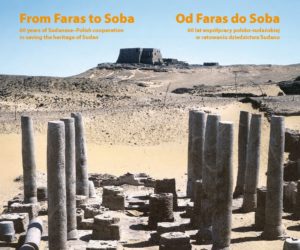Warsaw 2022
ISBN 978-83-953362-6-3
ISBN 978-83-953362-7-0 (pdf online)
Pages: 504The title “From Faras to Soba” refers to two capital cities of medieval Nubia. Faras is almost 1400 km down river from Soba, going by the Nile. The two sites are also at two ends of a time spectrum: 60 years ago, in Faras in 1961, Kazimierz Michałowski and the Centre of Mediterranean Archaeology in Cairo led the first Polish excavations in Sudan. Today, Soba is one of the newest archaeological projects run by the Polish Centre of Mediterranean Archaeology of the University of Warsaw. In the meantime—as well as physically in between—is Old Dongola, the third great medieval Nubian kingdom, where Polish archaeological investigations have been going on uninterrupted for more than half a century.
Civilization emerged and developed in Nubia much earlier, in the 3rd millennium BCE. For 60 years now Polish researchers have been involved in the challenging task of discovering the remains of these cultures, their description and saving from oblivion and destruction.
This 500-page, richly illustrated volume showcases also the achievements of Polish Nubiology: the discoveries made by archaeologists, the research of specialists from a variety of sciences, the restoration projects undertaken by art restorers and conservators. Prime among these are the great surveys covering long stretches of the Nile river valley and large expanses of the inhabited desert regions on either side. Such work in Sudan often took on a salvage dimension, preceding major dam- and road-construction works.
The book presents discoveries from many different periods and cultures: the oldest hominin traces in the region, the development of Kerma culture in the 3rd and 2nd millennia BCE in the Bayuda Desert, the burial rites in the kingdoms of Kush and Meroe (1st millennium BCE and 1st millennium CE) and the mysterious Early Makuria (4th–5th centuries CE) directly before the rise of the Christian kingdoms of Nubia. An extensive section of the book is devoted to archaeological and conservation work at the medieval Christian sites of Old Dongola, Banganarti, Selib, Ghazali and Soba. Some of the wall paintings discovered at Dongola and Banganarti, which have been restored by Polish specialists, are a match for the murals from Faras that are the pride of the National Museum in Warsaw.
Some of the comprehensive research on various categories of finds has also been presented in the volume: studies of the textual heritage of Christian Nubia, of cultural identity and trade contacts based on personal adornments, of the natural environment as seen through the history of livestock breeding in the Middle Nile Valley, and the bioarchaeology of the Nubian elite.
There is also a story about the people living today among the historic monuments. Collaborative archaeology is an approach that develops the role of local communities in archaeological projects, so that the discoveries made by archaeologists become more than just textbook content. It shows how the forgotten heritage can be woven into the fabric of modern life to make it live again.
This book was financed by the Ministry of Education and Science of the Republic of Poland for the task „Internationalization of research of the University of Warsaw Archaeological Research Centers”.
For download:
Full Text (in CEON)
- Contents (PDF)










 Stumble It!
Stumble It!

No comments:
Post a Comment